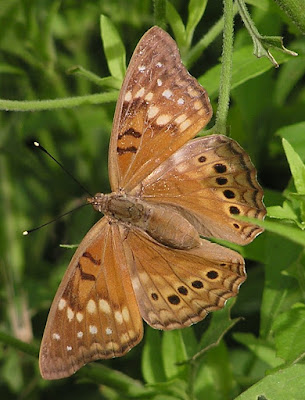About a dozen people gathered to take a cruise down Boca Chica Boulevard for some coastal plain and beach specialties! Norma led the way out of Stripes on Ruben Torres, but at the road construction we lost the two lead cars, and Pat and I followed by Alan and Baceliza ended up following a pickup going east and eventually down a little dirt road called Medford that had a great little wetland that was stuffed with stuff, including a Wood Stork! Someone got on the horn and had the other two cars come over, and as it turned out, this was the little spot that Alicia had wanted us to stop at on the way! Several kinds of herons and shorebirds fed, including all three common peeps, lots of juvenile Common Gallinules, a young Gull-billed Tern, and our only Wilson's Phalaropes of the day! In the songbird department we had Loggerhead Shrike, Tropical Kingbird, a Curve-billed Thrasher, and a singing Carolina Wren, while a Ringed Kingfisher flew overhead
Waders along Medford Road
Great Egrets, Wood Stork, and Great Blue Herons
Gang trying to see the birds through the fence...
On we went, and I encouraged Norma to lead again as she and Alicia are the better spotters! :-) We stopped at the hacking station just past the Border Patrol checkpoint, but unfortunately had no Aplomado Falcons; in fact, it was rather quiet at that stop.
So on we went to the viewing platform in the National Wildlife Refuge, where quite a few things were singing but very little showed themselves: Botteri's Sparrows, a Roadrunner, White-eyed Vireos, Bewick's Wrens, and Verdin were all present but uncooperative. An empid of some kind did pop up, but we couldn't tell which at that distance (except that it wasn't a Yellow-bellied).
Heading down the dirt road we had a large flock of White-faced Ibis fly overhead, plus lots of Eastern Meadowlarks flushing. Both Barn and Cliff Swallows fed low over a little marsh, and an Upland Sandpiper flew overhead unseen. Turning the corner into the thornscrub, I drove around the next corner to take a "break" where a Roadrunner was standing in the middle of the road and a family of Groove-billed Anis flew across! Heading back to the gang Norma put out her hand to indicate that they had something, and as I walked up, they thought they had a Yellow-green Vireo! Most of us never saw the bird, but they felt confident about the ID based on what they saw. A couple of Yellow Warblers showed up across the road, and a sharp pit alerted us to the presence of an Alder Flycatcher, which soon popped up for all to see! Thankfully another family of anis crossed the road, so everyone got to see them. On the way out a beautiful Eastern Kingbird posed, and a White-tailed Hawk flew by in the distance.
Eastern Kingbird (also below)
From there we headed to "Dan's Road," but not before stopping for a load of shorebirds (in the sun of course), where we managed to pick out a couple of Snowy Plovers along with a Semipalmated, several dowitchers, some Reddish Egrets, and a couple of Horned Larks. Heading down Dan's Road to the river we picked up a squealing Royal Tern and a Neotropic Cormorant for the day along with a Spotted Sandpiper, and since Dan had reported Seaside Sparrows last month down the "bad" part of the road (which at the moment actually looked pretty good), we decided to brave it and head down! There was quite the hump to get over at one point, and we marveled later at the fact that Marilyn was able to get her Toyota Sierra over it, but we discovered later that she had found another route in... ;-) We found the mangroves, but no sparrows; I think we had a Long-billed Curlew in here, and Pat spotted a nighthawk snoozing on a branch while Norma spotted a female Belted Kingfisher that the rest of us missed, but that was about it.
"Dan's Road"
The gang looks for Seaside Sparrows
Wilson's Plover
American Oystercatchers
Ghost Crab
Photo op...
Piping Plover
Black-bellied Plover
We called it a day after that, having much better looks at all the Harris' Hawks we had passed on the way down! Bird List:
Black-bellied Whistling-Duck
Blue-winged Teal Northern Bobwhite
Pied-billed Grebe
Wood Stork
Neotropic Cormorant
Brown Pelican
Great Blue Heron
Great Egret
Snowy Egret
Little Blue Heron
Tricolored Heron
Reddish Egret
White Ibis
White-faced Ibis
Turkey Vulture
Harris's Hawk
White-tailed Hawk
Common Gallinule
American Coot
Black-necked Stilt
American Oystercatcher
Black-bellied Plover
Snowy Plover
Wilson's Plover
Semipalmated Plover
Piping Plover
Killdeer
Spotted Sandpiper
Greater Yellowlegs
Willet
Lesser Yellowlegs
Upland Sandpiper
Long-billed Curlew
Ruddy Turnstone
Sanderling
Least Sandpiper
Semipalmated Sandpiper
Western Sandpiper
Short-billed Dowitcher
Wilson's Phalarope
Laughing Gull
Ring-billed Gull
Least Tern
Gull-billed Tern
Royal Tern
Eurasian Collared-Dove
Mourning Dove
Common Ground-Dove
Yellow-billed Cuckoo
Greater Roadrunner
Groove-billed Ani
Common Nighthawk
Ringed Kingfisher
[Belted Kingfisher]
Golden-fronted Woodpecker
Crested Caracara
Alder Flycatcher
Brown-crested Flycatcher
Great Kiskadee
Tropical Kingbird
Eastern Kingbird
Loggerhead Shrike
White-eyed Vireo
[Yellow-green Vireo]
Horned Lark
Barn Swallow
Cliff Swallow
Verdin
Carolina Wren
Bewick's Wren
Curve-billed Thrasher
Long-billed Thrasher
Northern Mockingbird
European Starling
Yellow Warbler
Botteri's Sparrow
Northern Cardinal
Blue Grosbeak
Dickcissel
Red-winged Blackbird
Eastern Meadowlark
Great-tailed Grackle
Bronzed Cowbird
Lesser Goldfinch
House Sparrow
84 Species






































































